

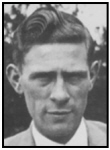
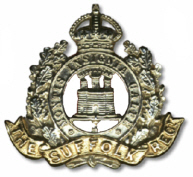
No.5827897, Private, Ernest John BARRETT
Aged 22

|
Ernest John BARRETT was born on 8th July 1919 in Haverhill (Risbridge Q3-1919 4A:1353), son of Ernest Edward and Marie Aimee Helene BARRETT(née GAMBIER). His mother was French.
and married his father in France in 1918 at Longfosse, Pas de Calais when his father was a private in the 18th Hussars. Mary's church six months later when his father's occupation was recorded as Mechanic. Two further children followed, Janet Mary in 1921 and Herbert George in 1923. When they were baptised their father's occupation was recorded as Tailor then Clock & Watch Maker, which he continued to be for the rest of his working life. In the 1939 register his father Ernest E [19-7-1891) a watch and clock repairer and his mother Marie H [8-8-1897] were at 1 Waveney Terrace, Haverhill. There are no closed records. His father died in 1959, address 8 Elm Close, Haverhill, his mother in 1987 (Newmarket reg). Ernest John attended the local Board school and afterwards when he worked for the Haverhill Co-operative Society. The family was still living at Waveney Terrace at the start of WW2 and John enlisted in the army and joined the 4th Battalion Suffolk Regiment. |


Ernest John was part of "C" Company who were based at Leiston then Lowestoft where they were responsible for coastal defences. Later in 1940, the 4th Battalion moved to St Neots, near Cambridge. In December 1940, the 4th Battalion, as part of the 18th Division, had orders to mobilize ready to proceed overseas. It was expected that they would be sent to Egypt to complete their training, after preliminary training in Scotland. Embarkation leave was taken and Ernest John returned home to be with his family. This was a difficult time for him as he suffered badly from nervous depression and didn't want to fight. A change of plan meant the 4th Battalion were to see a great deal more of England, on further training and defensive duties, before embarking on 29th October 1941 at Liverpool aboard S.S. 'Andes' as part of a large convoy. They crossed the Atlantic to Halifax, Nova Scotia, where they re-embarked, together with the 5th Battalion, on the U.S.S. 'Wakefield', and they began the long voyage, via Trinidad, to Cape Town. Whilst in South Africa news arrived of the Japanese attack on Pearl Harbour, although many still believed their destination was Egypt, some guessed Singapore. They arrived at Bombay on the day after Boxing Day and spent 2 weeks ashore getting fit. After they were back at sea it was known that their destination was Singapore and pamphlets on jungle warfare were issued. The news was not encouraging but spirits were said to be high. The U.S.S. Wakefield berthed at Singapore on 29th January, the same day as it was decided to evacuate the mainland for the defence of the Island. The 4th and 5th Battalions at once disembarked to defend the north-east of the Island, an extensive front of some open beach and long stretches of mangrove swamps. Ernest John's niece Jacqueline recalls:"Unfortunately soon after landing he was badly injured, I believe it to have been a bullet wound, and he died of his injuries in hospital (on 15th February) leaving his family devastated, something his mother never got over." However it is more likely that his wounds did not kill him and something far more barbaric was the cause of his death. To set the scene: The Alexandra Military Hospital had a normal capacity for 550 patients but the battle for Singapore had swelled the numbers to 900 patients. The Alexandra Military Hospital was meant to be a sanctuary amidst the violence and turmoil of war. Like all military hospitals it was to be protected by the Red Cross, the international symbol of medical sanctuary. But on 14th and 15th February 1942 this hospital was violated by the most awful massacre. At about 1pm on 14th February 1942, Japanese soldiers entered the hospital, bayoneting staff and patients. Among the casualties was a British officer, who was carrying a white flag, to signify the hospital's surrender. About 50 men were killed at this time, victims included 2 patients lying on the operating tables on the ground floor of the surgical block, as well as doctors and other patients. Around 3:30 p.m., 200 men, patients and medical staff, were rounded up, tied into groups of eight and forced to march to a row of sheds where they were kept overnight. The gravely injured were killed if they fell along the way. There was no ventilation or water in these sheds and they had neither space to sit nor lie down. Under these terrible conditions, some men died during the night. The following morning, the surviving men were told that they would receive water. However, the Japanese troops systematically took prisoners out in pairs and bayoneted them, before pushing their bodies into a mass grave at the rear of the hospital. Affidavits claim that around 250 people were massacred during these two days. Ernest John's death is recorded as being 15th February and he is commemorated on the Singapore Civil Hospital Grave Memorial which was established for those who died in the Alexandra Hospital Massacre on 15th February. It is of little comfort to know that the junior Japanese Officer who ordered the massacre at Alexandra Military Hospital was executed when more senior Japanese officers arrived on the scene. After the war, as there had been over 400 buried in an emergency water tank in the grounds of the civilian hospital and no identification would be possible, the grave was left undisturbed, suitably enclosed and consecrated. A cross in their memory still exists near block 8 in the grounds of the hospital. The names of 107 Commonwealth service personnel buried there are engraved on a special Singapore Civil Hospital Grave memorial, within Kranji War Cemetery. |
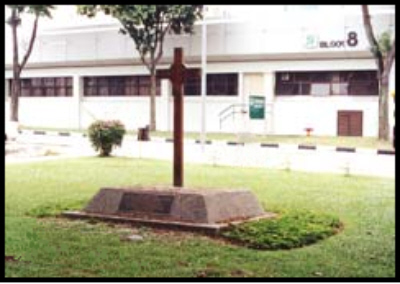
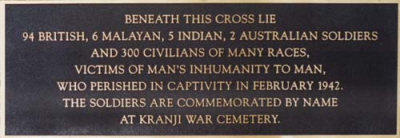
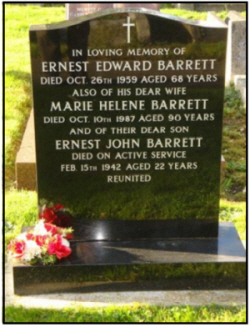
photo: Commonwealth War Graves Commission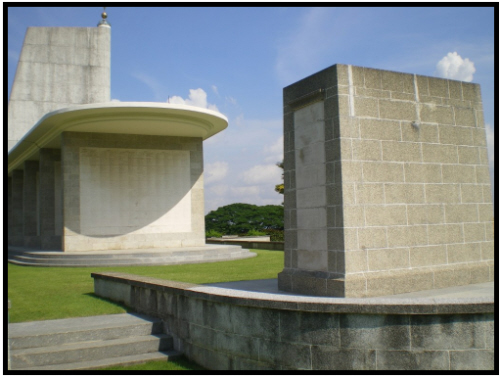
click here to go to the Commonwealth War Graves Commission website for full cemetery/memorial details